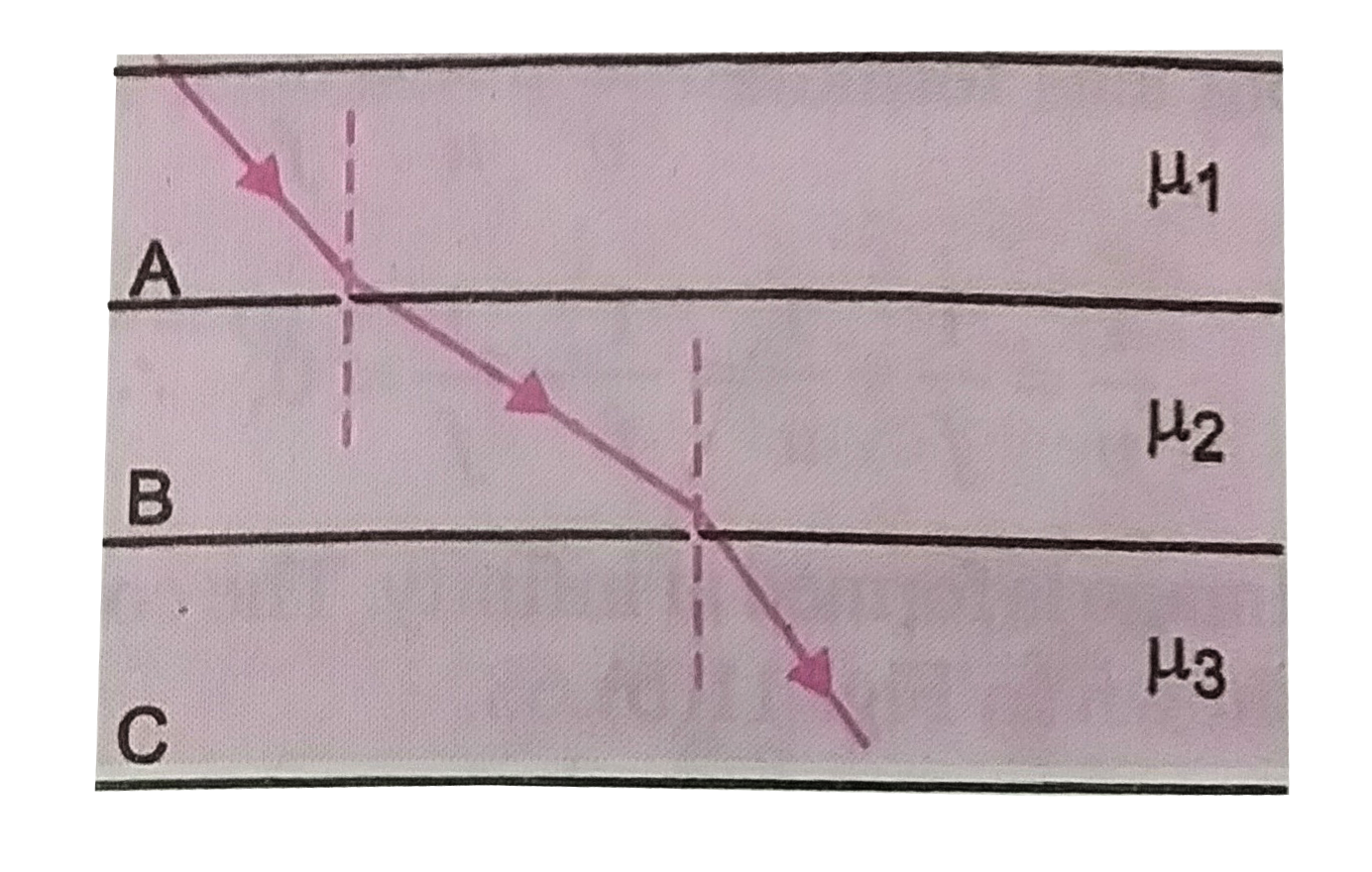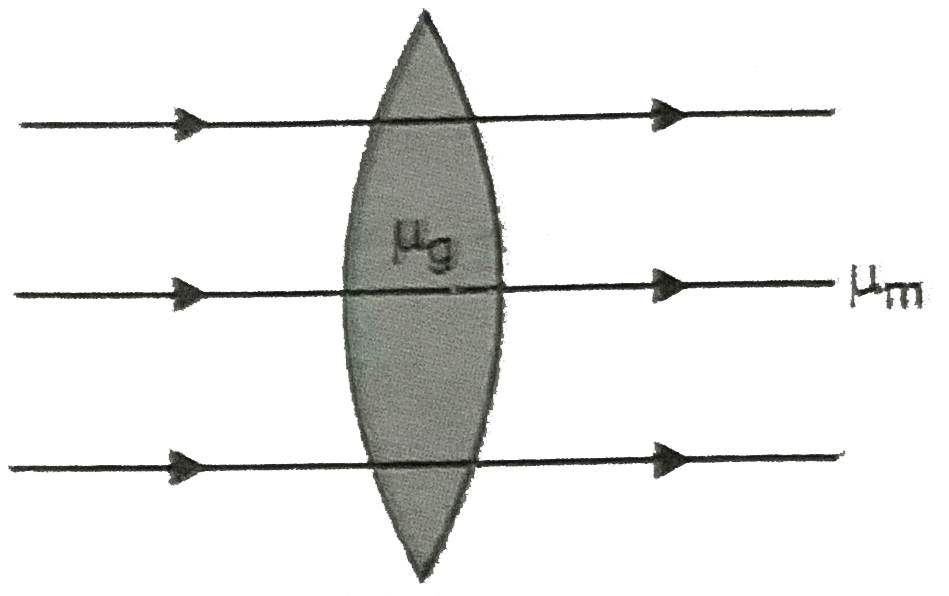Complete Solutions to Conceptual problem(b) of chapter RAY OPTICS of Class 11 book with complete answers and questions
| Class 11 | PHYSICS |
| Chapter | RAY OPTICS |
| PRADEEP | Conceptual problem(b) |
| Number Of Questions | 22 |
| Academic Year | 2023-24 |
Why does a ray of light bend towards normal as it passes from air to glass ?
View SolutionHow do the frequency and wavelength of light change when it goes from a rarer to a denser medium ?
View SolutionCan the relative refractive index of a medium w.r.t. another medium be less than unity ?
View SolutionCan the absolute value of refractive index of a medium be less than unity ?
View SolutionWhen light comes from air to glass, the refracted ray is bent towards the normal. Why ?
View SolutionIf a plane glass slab is placed on letters of different colours, then red coloured letter appears to be raised minimum, why ?
View SolutionThe critical angle for glass air interface is `C` and for glass water interface is `c'`. How are `C and C'` related ?
View SolutionWhy does a diamond shine ?
View SolutionExplain why
(a) A diamond glitters in a brightly lit room, but not in a dark room.
(b) A crack in a window pane appears silvery.
( c) The bubbles of air rising up in a water tank appear silvery when viewed from top.
View SolutionPath of ray of light passing through three liquids of refractive indices `mu_1,mu_2,mu_3` is as shown in Fig. Which liquid has the smallest index of refraction ?
 .
.
View SolutionA ray of light after refraction through a concave lens becomes parallel to the principal axis after refraction through the concave lens. Explain with a ray diagram when this can happen.
View SolutionThe surfaces of the sun glasses (goggles) are curved, yet their power may be zero. Why ?
View SolutionCalculate the position of the image of an object when placed at
(a) focus of a convex lens.
(b) focus of a convex lens.
View SolutionA concave lens made of a material of refractive index `n_1` is kept in a medium of refractive index `n_2`. A parallel beam of light is incident on the lens. Complete the path of rays of light emerging from the concave lens (i) `n_1 gt n_2` (ii) `n_1 = n_2` (iii) `n_1 lt n_2`.
View SolutionFollowing data was recorded for values of object distance and the corresponding values of image distance, in the study of real image formation by a convex lens of power `+ 5 D`. One of these observations is incorrect. Identify and give reason :
`{:("S.No",1,2,3,4,5,6),("Object distance (cm)",25,30,35,45,50,55),("Image distance (cm)".97,60,37,35,32,30):}`
View SolutionA thin lens focal length `f_(1)` and its aperture has diameter `d`. It forms an image of intensity `I`. Now the central part of the aperture up to diameter`(d)/(2)` is blocked by an opaque paper. The focal length and image intensity will change to
View SolutionWhen does a convex lens behave as a concave lens ?
View SolutionA lens immersed in a transparent liquid becomes invisible. Under what condition does it happen ?
View SolutionA lens is forming the image of an object on its axis. If the lens is placed with its faces reversed, will the position of image change ?
View SolutionWhat happens to focal length of a convex lens when it is immersed in water ?
View SolutionThe radii of curvature of both the surfaces of a lens are equal. How will its focal length and power change if one of the surfaces of the lens is made plane ?
View SolutionA convex lens of refractive index `mu_g` is held in a reansparent medium of refractive index `mu_m` If course of rays is as shown in Fig., how are `mu_g and mu_m` related ?
 .
.
View Solution
Conceptual problem(b) questions and complete solutions for chapter RAY OPTICS of PRADEEP PHYSICS (HINGLISH) of Class 11
All Exercises from PRADEEP Class 11 PHYSICS RAY OPTICS
- (Competition)Comprehension
- (Competition)Multiple choice
- (Exemplar) Multiple choice
- (NCERT)Exercise With Solution
- (NCERT)Long Answer
- (NCERT)Short Answer
- (NCERT)Very Short Answer
- (Test Your Grip)Fill in the blanks (b)
- (Test Your Grip)Fill in the blanks (c)
- (Test Your Grip)Fill in the blanks (d)
- (Test Your Grip)Fill in the blanks(a)
- (Test Your Grip)Multiple Choice (b)
- (Test Your Grip)Multiple Choice (c)
- (Test Your Grip)Multiple Choice (d)
- (Test Your Grip)Multiple Choice(a)
- (Test Your Grip)Multiple Choice(sec -A)
- Assertion-Reason Question
- Conceptual Problem(a)
- Conceptual problem(b)
- Conceptual problem(c)
- Conceptual problem(d)
- Higher Thinking Order
- Integer Question
- Long Answer (a)
- Long Answer (b)
- Long Answer (c)
- Long Answer (d)
- Problem For Practice(a)
- Problem For Practice(b)
- Problem For Practice(c)
- Problem For Practice(d)
- Sample Problem(a)
- Sample problem(b)
- Sample problem(c)
- Sample problem(d)
- Short Answer(a)
- Short Answer(b)
- Short Answer(c)
- Short Answer(d)
- Solved Example(a)
- Solved Example(b)
- Solved Example(c )
- Solved Example(d)
- Very Short (a)
- Very Short Answer (b)
- Very Short Answer (c)
- Very Short Answer (d)